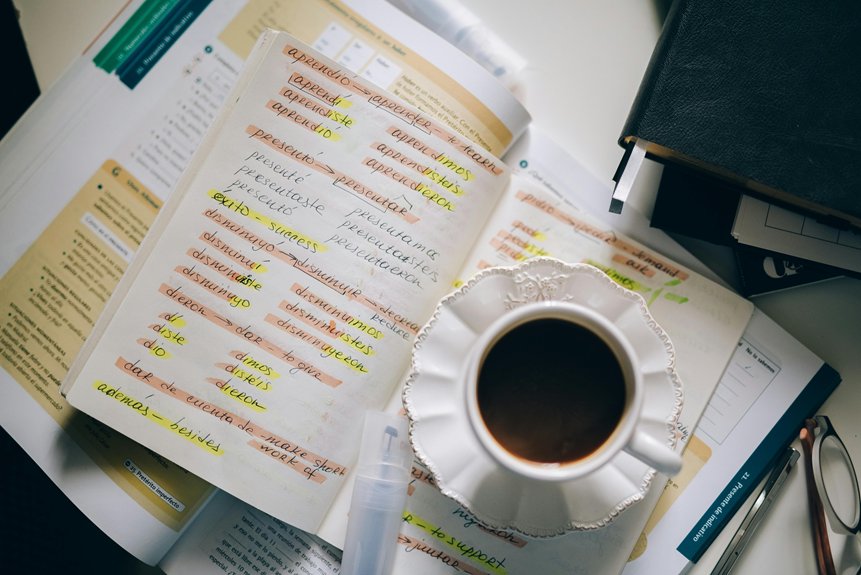
When it comes to learning Spanish, using flashcards can really streamline your study process. You can create cards that not only feature vocabulary but also include images and example sentences for context. This approach helps you connect words with their meanings more effectively. However, knowing how to organize and review your flashcards is key to maximizing their potential. Let’s explore some strategies that could enhance your learning experience.
Benefits of Flashcards in Language Learning
Flashcards offer several key benefits for learning Spanish effectively. They facilitate active recall, a powerful technique that helps you remember vocabulary and phrases for real conversations.
By using spaced repetition, you review words at increasing intervals, enhancing long-term retention. This method guarantees you don’t just memorize but truly internalize the language.
Plus, you can customize flashcards with images, audio, or context-based examples, catering to your unique learning style. Studies show that they improve learning efficiency, allowing you to cover more vocabulary in less time compared to traditional methods.
Incorporating flashcards into your daily routine boosts engagement and motivation, letting you track your progress and celebrate milestones in your Spanish learning journey. Embrace the freedom of effective learning!
Creating Effective Flashcards
To make the most of your Spanish study, creating effective flashcards is key. Start by including both the Spanish term and its English translation on each card to reinforce vocabulary retention.
You can take it a step further by adding images or illustrations to create visual associations, boosting memory recall. Incorporate example sentences to provide context, showing how vocabulary fits into real-life situations.
Organizing your flashcards by themes—like food, travel, or greetings—can help you focus during study sessions and improve recall of related terms.
Don’t forget to regularly review and shuffle your flashcards to guarantee you’re genuinely learning the content, not just memorizing the order. This approach gives you the freedom to learn efficiently and effectively.
Techniques for Reviewing Flashcards
While reviewing flashcards can seem straightforward, using specific techniques can greatly boost your retention of Spanish vocabulary and concepts.
Start by employing spaced repetition; review your flashcards at increasing intervals to cement your memory over time. Test yourself actively with each flashcard, as engaging in active recall markedly enhances retention compared to merely flipping through.
To make connections easier, group your flashcards by themes or topics, creating context for related terms. Don’t hesitate to shuffle your flashcards regularly, preventing dependency on their order.
Finally, consider adding images or mnemonic devices to engage your visual memory, making recall quicker and more effective during your study sessions. Embrace these techniques for a more liberated learning experience!
Enhancing Flashcards With Visuals
Incorporating visuals into your flashcards can greatly enhance your Spanish study experience. By adding images or icons, you create strong associations between words and their meanings, boosting your memory retention.
Research shows that color-coded visuals help categorize vocabulary, making recall easier during practice. Plus, flashcards with pictures engage multiple senses, turning your learning into an interactive and enjoyable journey, which ultimately leads to better language acquisition.
Consider using infographics or diagrams to visualize complex concepts or grammar rules, simplifying your understanding. Including culturally relevant images not only deepens your connection to the language but also enriches your learning experience, making it more meaningful and contextually relevant.
Get creative and watch your Spanish skills flourish!
Setting Goals for Flashcard Study Sessions
Setting clear goals for your flashcard study sessions can considerably boost your learning effectiveness. Aim to learn a specific number of vocabulary words, like 10 per session, to keep your focus sharp. Set a time limit—20 minutes is perfect for maintaining intensity without burning out.
Incorporate spaced repetition; aim to review each flashcard at increasing intervals for better long-term retention. Track your progress by noting how many flashcards you’ve mastered; this can be a huge motivator.
Additionally, consider setting thematic goals, like tackling food vocabulary or common verbs, to make your study sessions more organized and relevant. By doing this, you’ll create a dynamic learning experience that feels both structured and liberating.
Conclusion
Incorporating flashcards into your Spanish study routine can greatly enhance your learning experience. By creating effective cards that blend visuals, context, and spaced repetition, you’ll solidify your understanding and retention of vocabulary. Don’t forget to set specific goals and regularly shuffle your cards to keep things fresh and engaging. With dedication and the right techniques, you’ll find yourself making steady progress in mastering Spanish. So grab those flashcards and start your journey today!



